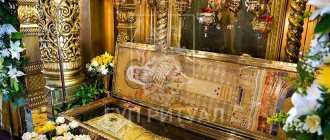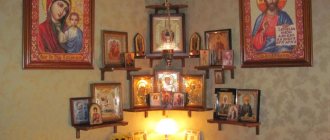An altar boy or sexton is a lay male who assists the clergyman during the service.
Sexton is an ancient Greek word meaning overseer or gatekeeper.
Previously, only priests were called altar servers, and assistants serving during divine services were called sextons. The term altar server took root in the 20th century.
Theoretically, the sexton is supplied by the bishop, but in practice this rule is not followed, and this service is blessed by the rector of the temple.
vestment
The sextons at the altar put on special liturgical clothing - a surplice. The abbot blesses the wearing of the surplice.
Before putting on the surplice, the sexton makes two bows from the waist towards the Throne, then takes a blessing for putting on the surplice from the bishop or priest, makes a bow from the waist without the sign of the cross towards the person who blessed him, then kisses the cross of the surplice and puts on the surplice.
It is prohibited to leave the church in a surplice for non-official business.
Requirements for an altar server
A man who participates in the Sacraments of Confession and Communion, leads a spiritual life and is reverent is chosen for the position of altar server.
Since the service of an altar server symbolizes the service of angels at the Throne of the Lord, strict requirements are put forward for the spiritual appearance of an altar server:
- Outwardly, the altar boy should look neat and modest, clothes should be clean, ironed, shoes should be polished, hair should be cut and combed.
- He must live spiritually, which means not only observing external piety, but also doing prayer, fighting passions, and paying attention to the inner life of the soul.
- The altar server needs to develop useful qualities of the soul - humility, hard work, piety, attentiveness.
- Particular attention should be paid to speech - its pace should be measured, the address to people should be meek, sedate, and polite.
According to Tradition, the altar boy, like other altar servers, displays the image of the Heavenly World, and will serve the Lord Jesus Christ in the matter of saving people.
Altar boy as a prototype of an Angel
The altar boy carries out three parish ministries: reader, sexton and paraecclesiarch. As a reader, he participates in worship, conveying to the church people the words of prayers and teachings (including the texts of the Holy Scriptures). As a sexton, he performs the sacred rites prescribed for him by the charter (entrances with candles, etc.) and helps (as if he serves) the clergy. As a paraecclesiarch, the altar boy keeps order in the temple during the service, prepares the temple premises and church utensils for the service and restores order after, prepares the substance of the Sacraments (bread, wine, oil, etc.).
The importance of serving as an altar boy imposes a special responsibility on the people who bear this obedience. Firstly, the altar server must be a person of high spiritual life, because Without inner prayer and without struggling with one’s own passions, it is impossible to serve (serve) at the Throne of God. The altar server should especially cultivate the virtues of humility, prudence, attentiveness, hard work and responsibility (not only for himself, but also for his fellow men). Secondly, the altar server must be literate in the church: know the rules of worship, the Church Slavonic language, the doctrine of the Orthodox Church, and must constantly improve his Christian education. Thirdly, the altar boy must be extremely strict with himself. This concerns not only the inner life of the soul, but also the external appearance of the clergyman. The altar server should behave meekly and sedately when dealing with people. His appearance should always be neat (clean hair, unwrinkled clothes; a plain shirt, black trousers and black polished shoes). The altar server's speech should be calm, polite and convincing.
Often in modern parish life one can find a disdainful attitude towards the service of the altar boy. However, the Tradition of the Church testifies to us that the altar boy, like other servants of the Altar, represents in himself and through his obedience the image of the heavenly world - the image of the Kingdom of God, prefiguring the Angels, and will serve Christ the Savior in the matter of saving people (the local church community) from sin and death.
Hieromonk Jerome (Zub)
Responsibilities of altar servers during the liturgy in the absence of a deacon
(download in Word format)
1) Light the lamps . Prepare wine . Before pouring wine into a jug, you should definitely taste it to see if it has turned sour or if there are any foreign flavors; it is ideal to pour the wine in the evening. Prepare water for the proskomedia, a small amount, so that only the bottom of the pot is covered; the water should be ordinary, not consecrated, not remnants of warmth from the last liturgy. Bring the notes to the altar. Read the memorials with the blessing of the priest during the proskomedia and at free intervals before the Cherubim. 2) Place the censer at the end of the proskomedia as directed by the priest (First, lift it with your right hand, your left hand holds the lower cup, so that the upper part does not interfere with holding the cover over the censer. Then release the lower cup to cense the large cover). Cut antidor . 3) When the incense begins, open the curtain of the royal doors . (Close it after the Great Entrance). Before the start of the liturgy, turn on the chandelier . 4) Small entrance. During the exclamation of the priest “For God is good and a lover of mankind, and to You we send glory...” before the start of the singing of the 3rd antiphon (usually “Blessed”), a sexton candle in a high place. The altar boy stands next to her. The beginning of the Small Entrance usually occurs during the singing of “Blesseds of Mercy” (if troparia are sung on “Blesseds”, then on “Glory”) the altar server synchronously crosses himself with the priest, bows to him, after the saint heads from the throne to the high place , approach the door with a candle, when the priest passes the high place, open the northern gate and go out. After blessing the priest at the entrance, the altar server enters the southern gate, puts the candle back on the high place, crosses himself and bows to the priest, and puts out the candle. 5) Reading the Apostle . During the singing of the Trisagion, holding the Apostle vertically in front of 6) During the reading of the Apostle (if there is only one altar boy, then before) serve the censer . 7) While singing the Alleluaria, bring the candle to the pulpit. If there is one altar boy, then after the Small Entrance he does not bring the candle into the altar, but leaves it burning in front of the icon of the Savior. After reading the Alleluary, a candle is placed in front of the pulpit. After reading the Holy Gospel, the candle is brought into the altar and extinguished. During the pronunciation of the funeral and funeral litanies, distribute the ordered commemorations among the serving clergy. 8a) Serve the censer if there is a funeral litany. The priest, reading the litany, censes the throne, standing with his back to the open royal doors. 9) Great entrance . 9a) After the priest reads the secret prayer “No one is worthy..”, provide a censer for censing the altar and iconostasis. While the saint censes the iconostasis on the salt, light a candle . At the end of the censing, pick up the censer . 9b) After the third reading by the priest, “Like the Cherubim,” approach the altar with a censer . Give it to the priest. a candle in your left hand - go out to the solea, stand in front of the pulpit. As soon as the saint places the Gifts on the throne, enter the altar. 9c) Immediately put and extinguish the candle, and place the censer high for censing the cover. 10) Exclamation “Let us love one another” - approach the curtain to open it. At the cry of “Doors, doors...” open the curtain . 11) While singing the Creed, the kettle . 12) While singing: “We sing to you...” (after the consecration of the Holy Gifts), after bowing to the ground, give the priest a censer for censing the Holy Gifts. 13) At the cry of “Let’s get out there!” Holy of Holies” close the veil. 14) Immediately bring a kettle of boiling water to the saint on a tray (pre-rinse the kettle with boiling water). 14b) Immediately place a candle in front of the Royal Doors. 15) At the end of the singing, read the prayers for Holy Communion. 16) Open the veil as directed by the priest. 17) Move the candle to the icon of the Savior. 18) Hold the cloth and wipe the mouths of the communicants. If the Holy Gifts get on the cards, do not allow them to fall to the floor. 19) After communion of the laity, provide a censer to burn the throne, and then the altar. 20) Light a candle on the altar. 21) Take the censer and present it again to the priest in front of the altar. 22) Take the candle from the pulpit to the altar after the exclamation: “Always, now and ever...” before the transfer of the Holy Gifts. 23) Distribute antidor. 24) Read prayers of thanks. 25) Give the priest a teapot with warm water to wash the Chalice.
During the pronunciation of the funeral and funeral litanies, distribute the ordered commemorations among the serving clergy. 8a) Serve the censer if there is a funeral litany. The priest, reading the litany, censes the throne, standing with his back to the open royal doors. 9) Great entrance . 9a) After the priest reads the secret prayer “No one is worthy..”, provide a censer for censing the altar and iconostasis. While the saint censes the iconostasis on the salt, light a candle . At the end of the censing, pick up the censer . 9b) After the third reading by the priest, “Like the Cherubim,” approach the altar with a censer . Give it to the priest. a candle in your left hand - go out to the solea, stand in front of the pulpit. As soon as the saint places the Gifts on the throne, enter the altar. 9c) Immediately put and extinguish the candle, and place the censer high for censing the cover. 10) Exclamation “Let us love one another” - approach the curtain to open it. At the cry of “Doors, doors...” open the curtain . 11) While singing the Creed, the kettle . 12) While singing: “We sing to you...” (after the consecration of the Holy Gifts), after bowing to the ground, give the priest a censer for censing the Holy Gifts. 13) At the cry of “Let’s get out there!” Holy of Holies” close the veil. 14) Immediately bring a kettle of boiling water to the saint on a tray (pre-rinse the kettle with boiling water). 14b) Immediately place a candle in front of the Royal Doors. 15) At the end of the singing, read the prayers for Holy Communion. 16) Open the veil as directed by the priest. 17) Move the candle to the icon of the Savior. 18) Hold the cloth and wipe the mouths of the communicants. If the Holy Gifts get on the cards, do not allow them to fall to the floor. 19) After communion of the laity, provide a censer to burn the throne, and then the altar. 20) Light a candle on the altar. 21) Take the censer and present it again to the priest in front of the altar. 22) Take the candle from the pulpit to the altar after the exclamation: “Always, now and ever...” before the transfer of the Holy Gifts. 23) Distribute antidor. 24) Read prayers of thanks. 25) Give the priest a teapot with warm water to wash the Chalice.
Reading order of the Apostle
Priest: Let's take a look. Peace to all. Reader: And to your spirit. Priest: Wisdom. Reader: Prokeimenon, voice (.): entire prokeimenon. Chorus: repeats the prokeimenon. Reader: Verse after the prokeimenon. Chorus – the entire prokeimenon. Reader: Prokeimenon (1st part - up to the comma). Chorus: 2nd part of the prokeemna. (If there is a second prokeimenon, then instead the reader: Prokeimenon, voice second prokeimenon in its entirety. Chorus: prokeimenon). Priest: Wisdom. Reader: ……….. * reading.
(Acts of the Saints Apostle reading (Or: the Epistle of Peter [or: John, and it is not customary to say which epistle this is - the first, or second, or third] reading. Or: To the Romans [To the Corinthians; To the Galatians; To Timothy, etc. .p.] reading of the epistle of the holy Apostle Paul.)) Priest: Let us take note. The reader reads the Apostle... (Starts in a slow, low voice, raising the tone; if there are two readings, then the first reading ends with a lower tone and then the tone rises again) Priest: Peace be with you who read. Reader: And to your spirit. Priest: Wisdom. If the deacon reads the Gospel from the pulpit, then move a little to the right.
If there is one reading, then the Reader: Hallelujah (3 times), the Choir sings “Hallelujah” three times in the indicated voice. Reader: 1st verse of the alleluia ; Chorus: “Hallelujah”, Reader: - 2nd verse of the alleluia, Choir: “Hallelujah”.
If there are two readings, then the Reader: Alleluia (3 times) and immediately the 1st verse of the alleluia ; Chorus: “Hallelujah”, Reader: - 2nd verse of the alleluia, Choir: “Hallelujah”. Reader: 1st verse of the second alleluia ; Choir: “Hallelujah”
In churches where they sing the znamenny chant instead of Hallelujah (3 times), they often pronounce the Hallelujah voice (.)
It is unacceptable to make mistakes when reading prayers; the emphasis in words must be placed correctly. Also, the reader must understand well the meaning of what is being read, correctly make logical stresses, stop at punctuation marks, etc. Reading should be recitative, without shouting, monotonous, without jumps that hurt the ear. If there is a lack of experience, it is necessary to review the text of the prayers in advance, and the text of the Apostolic Readings, Prokeemna, and Alleluia must be viewed in advance in any case.
The candle is lit with the stub of another candle. When they light or take away a candle from a high place, they first cross themselves and bow to the high place and bow to the throne.
How to give a censer to a priest. Hold the ring with your right hand, pull out the chain of the lid with your left hand and grab all the chains.
Definition of the apostolic principles and reading of the prokeimns, alleluaries, troparions, kontakia
If there are 2 troparions on the clock, then: troparion 1 - Glory.. - troparion 2 - And now.
The kontakion is always read alone. At the 3rd hour the first one, at the 6th hour the second one.
If there are 2 prokeimenons, then: prokeimenon, voice... (1st prokeimenon) - verse - prokeimenon voice... (2nd prokeimenon).
Definition of the conception of the Apostolic Reading, Prokeemnon and Alleluary.
- We open the chapter “Collection of 12 months” (non-permanent calendar). Conceived in the Apostle through (from beginning to end). If there is no holiday with reading on this day, then step 2.
- Chapter “Prokimny... daytime” (by days of the week). Select the appropriate day.
- On Sunday. Chapter “Prokeemny... liturgical eight voices.”
- If we want to commemorate a locally revered saint, then the chapter “Prokeemnes... common to the saints.”
- During the Easter cycle we use the “Tale of Antiphons and Prokeimenons” (rotating calendar).
While reading the Apostle, we gradually raise our voice and end on 3 notes.
If there are 2 apostolic readings (a holiday and a saint), then at the end of the first the voice is lowered. Without announcement, we immediately read the second reading from the same low note. Further, as one reading.
Rules of conduct for altar servers
(download in Word format)
Before entering the temple, you must turn off your mobile phone.
Upon entering the holy altar, the altar server must reverently make three prostrations before the holy throne, cross himself with a bow towards the High Place and approach the senior clergyman for a blessing.
On Saturday, Sunday and holidays, according to the Typicon, only bows from the waist are to be performed.
Before putting on the surplice, it is necessary to ask for a blessing to put on the surplice from the serving priest or from the bishop (if during the service it is necessary to remove the surplice, then it is no longer necessary to take a blessing to put on the surplice again).
The duties of the altar attendant include monitoring the seven-branched candlestick, lamps and altar candlesticks, except those that stand on the throne. The latter are watched by the clergy. Persons who do not have holy orders are not allowed to place or remove lamps and candlesticks from the throne. In addition, the altar server must carefully monitor the censer so that the coal burns in it at the right time.
The altar boy must present the censer to the serving deacon from the right side of the holy altar.
When passing through a mountainous place, it is necessary to make the sign of the cross. Before presenting the censer to the deacon, the altar boy must cross himself with him towards the icon of the high place and bow to the serving priest. It is recommended to take the censer from the deacon in the same place and with the same actions that should be done before serving the censer.
You should try to walk around the altar as little as possible. Conversations and laughter in the altar are unacceptable. It is allowed only in a whisper, calmly, to say something concerning the service. During the Eucharistic canon, the Cherubic song and the reading of the Gospel there should be no extraneous actions or speech, except for prayers.
Touching the throne and the altar, passing in front of the throne (between it and the Royal Doors), and entering/exiting through the Royal Doors is strictly prohibited.
Food products (and especially those of animal origin) are prohibited in the altar.
It is advisable not to make notes in the liturgical books.
In case of any type of bleeding, the altar server must immediately leave the altar.
How to hold the plate during communion
During the communion of the laity, the altar boy may be invited by the priest to hold the cloth and wipe the lips of the communicants. This obedience should be performed with the utmost attention and caution. It is important to ensure that communicants:
- they held their hands on their chests in a cross;
- under no circumstances were they baptized in front of the Chalice;
- the children immediately swallowed the Holy Gifts.
You should hold the board wide (fully unfolded) and be prepared for the child or adult to make a sudden movement or even cough.
If the baby is in the arms of the parents, then they should put his head towards their right hand. The altar boy should hold the baby's hands.
Altar Server Responsibilities
The range of duties of a servant and the procedure for performing them are set out in the Charter of Sextons.
A short list of tasks performed by altar servers:
- lighting lamps in the altar and on the iconostasis;
- replacement of the holiday icon;
- lighting a censer;
- preparing wine, prosphora, warmth, incense and coal for the beginning of the service;
- serving censer;
- preparation of vestments;
- preparation of church vessels for the Sacraments;
- assistance during the fulfillment of requirements;
- holding the fee during Communion.
In addition, the altar boy is responsible for cleaning the temple. If necessary, the altar server performs the duties of a reader and bell ringer.
The altar boy is forbidden to touch the Throne, the Altar and the Sacred Vessels and cannot pass between the Throne and the Royal Doors.
Home » Liturgical life » Clergy » Altar serversAltar servers
The altar is, first of all, the place where the Divine and Bloodless Sacrifice is offered. According to Chrysostom, the priest performs the Liturgy in the concelebration of the Heavenly Powers, who “in reverence and great silence surround the altar and stand before the celebration of the great Sacrament.”
Our reverence for this place is expressed in our desire to decorate it as beautifully as possible. The altar boy monitors the splendor, cleanliness and decoration of the altar. He is the chief assistant to the priest - he prepares everything necessary for the service, and during the service he will always serve what is necessary. In addition, altar servers decorate the altar with their service, preceding the exit of the clergy with lighted candles and the removal of shrines. Altar boy is a difficult and honorable obedience. Among our altar servers you can see many very young guys, as they say, youths. Direct, active participation in the service gives them the opportunity to get to know and truly love the service. And cleaning and keeping the altar clean, which they successfully cope with under the supervision of their elders, accustoms them to a sense of reverence for the shrine.
The altar server must come to the temple before everyone else, before the start of the service, in order to prepare everything necessary for the service. He brings the necessary vestments and puts them in a certain order. The folding method does not symbolize anything, everything should just be convenient and practical, so that the priest does not waste a lot of time, but can put everything on himself one by one, in order. The deacon's vestments are folded in the same way, then the altar vestments.
In addition, you need to prepare the wine, heat the water, lay out the prosphora, prepare candles for the throne. Since the altar boy cannot touch the altar and the altar, everything necessary is placed in front of the altar so that the priest, starting to serve, can immediately transfer everything to the altar and begin the proskomedia.
During the proskomedia, a censer is served, it must already be ready, the coal must be lit. During the service, the altar boy must give the priest either a censer, or warmth or prosphora, bring notes, ring the bell, and if there is no one in the choir, read the clock. We have many altar servers in our church, but two are enough, and on weekdays one can handle everything. It is, of course, difficult for an altar boy to keep up with everything alone. And it happens that the priest serves himself, without altar boys. In this case, he has to fulfill his duties - priestly, and deacon, and altar boy.
eskie. But, in principle, two altar boys in the altar are the best option. And we have a lot of altar servers in order to attract the younger generation so that they can join this work. The greatest difficulties occur on major holidays - the Great Ones, the Twelves, especially Easter.
Of course, the hottest service is on Easter. Ordinary ordinary Sunday services take place according to a certain developed plan (all actions are memorized and done automatically), but Easter services are completely out of this order. It happens once a year, it is very difficult to remember everything, and the biggest difficulties are associated with dressing up priests, especially if there are many of them. The vestments are of different colors, they cannot be confused: you need to know exactly the order of the colors and the time when the priest vests. And at the same time, speed is important, you need to quickly remove from one priest, put on another, and serve both the three-candlestick and the censer. There are many different nuances during the Easter service and the services of Bright Week. There is such a temptation at the altar that a person gets used to the altar and is no longer reverent. The transition from the temple to the altar is, of course, a serious moment. You need to be stricter with yourself. When you enter the altar for the first time, you are afraid to move, such a state cannot be expressed in words. And when, year after year, every Sunday you enter the altar, constantly doing something that has already become part of everyday life, a moment may come when the fear of God is lost. The priest must notice this in time and stop it, pull the altar boy down. But this happens not only to altar servers, but also to deacons and even priests. This is very dangerous and serious.









